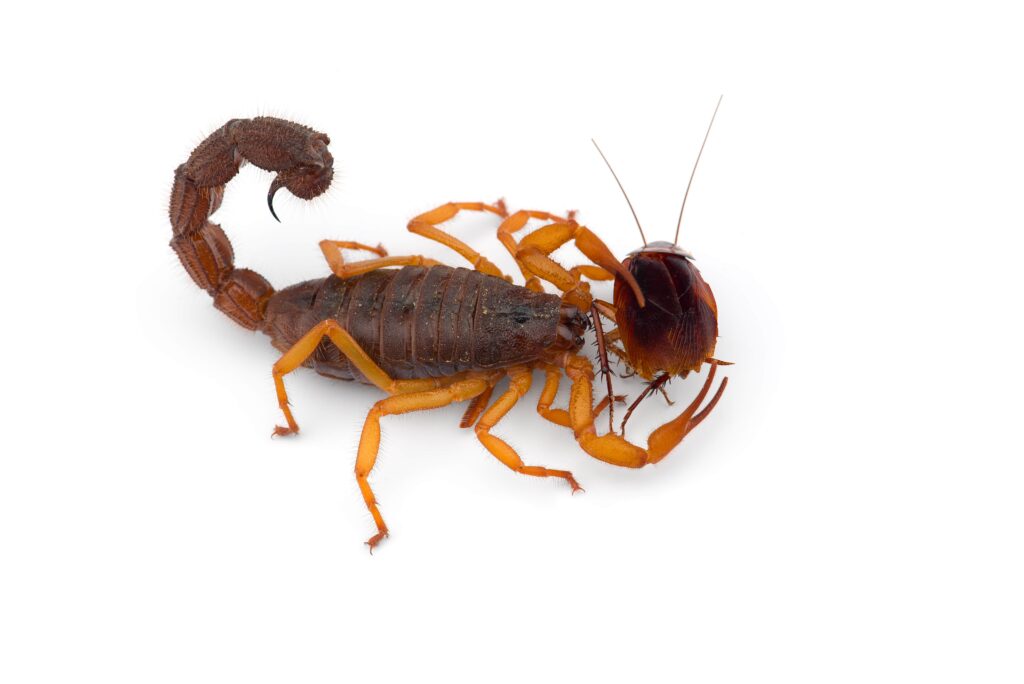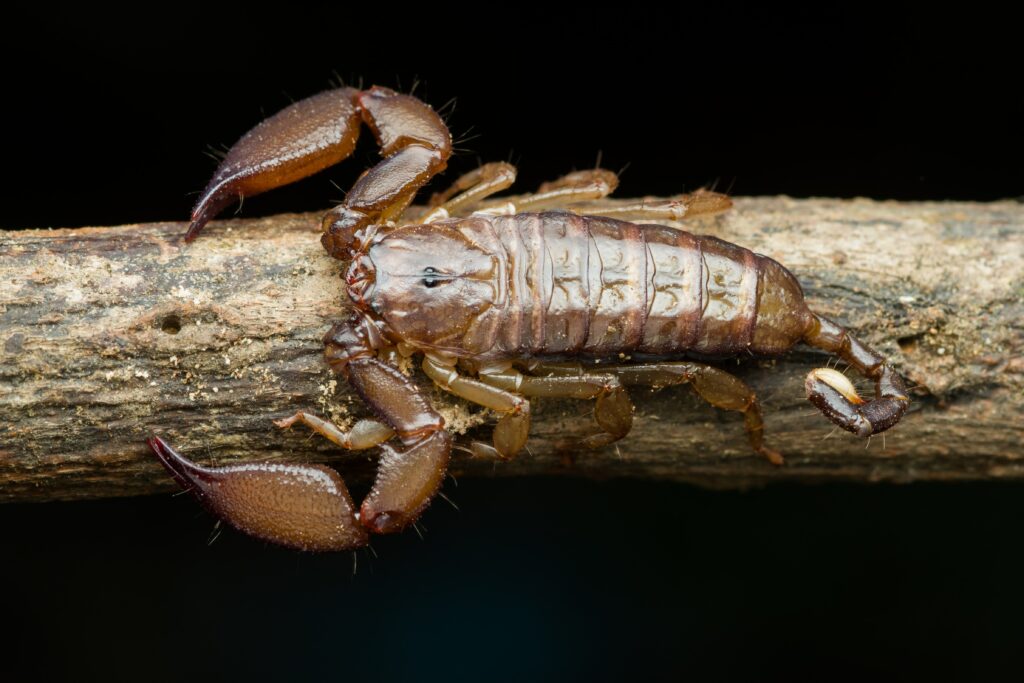A Brief Overview of Scorpions
Scorpions are fascinating creatures that belong to the class Arachnida, which also includes spiders, ticks, and mites. They have been around for millions of years and are found all over the world except for Antarctica.
There are over 2,000 species of scorpions, and they come in a wide variety of shapes, sizes, and colors. Scorpions live in a variety of habitats, including deserts, forests, grasslands, and even underwater.
Most species prefer warm climates and can be found in places like South America or Arizona Bark scorpions while others like whip scorpions can be found worldwide. They are nocturnal animals that avoid sunlight during the day and come out at night to hunt for insects or small animals.
Journey into the Enigmatic World of Scorpions: Unveiling Their Behavior and Characteristics! Experience the thrill of exploring the enigmatic world of scorpions as we unveil their intriguing behavior and characteristics. Immerse yourself in our informative article on scorpion behavior and characteristics for a deeper understanding!
Question: How Many Legs Do Scorpions Have?
When most people think about scorpions, one question that often comes up is: how many legs do they have? The answer might surprise you!
Like all arachnids (except sea spiders), scorpions have eight legs. However, their legs are not like those of insects because they don’t use them just for walking.
The legs on a scorpion’s body serve multiple purposes. In addition to walking legs, they also use them to climb trees or rocks when hunting prey or escaping predators.
The movements of their feet allow them to detect vibrations from prey or danger approaching making it easier for them to perceive their surroundings. Some people think that all scorpions are dangerous because they have a venomous sting; however, only about 25 out of 2000 species (that is only 1%) pose any real threat to humans.
The most lethal type of scorpion is the Arizona bark scorpion venom, which can be considered life-threatening for young children, the elderly, and those who have allergies. In the next section, we will take a closer look at scorpion anatomy and explore the structure and function of their legs.
Basic anatomy of scorpions
Scorpions are fascinating creatures that belong to the Arachnid family, which also includes spiders, whip scorpions, and many other arachnid species. Their distinct physical features make them a unique and intriguing creatures. A scorpion’s body is divided into three parts: the head, thorax, and abdomen.
The head contains two grasping pincers that are used for hunting prey and self-defense. These pincers are connected to venom glands that produce toxic chemicals that can paralyze or kill their prey.
The thorax is where the legs and respiratory organs are located. And lastly, the abdomen houses the digestive system along with reproductive organs.
A typical scorpion has eight legs placed on its thorax in pairs of four with each set facing opposite directions. The first pair of legs is called pedipalps which function as feelers and help them navigate their surroundings by detecting vibrations in the environment.
Some species can vary in length from 9mm to 20cm (3/8 inch to 7-7/8 inches) long! Desert scorpions have developed long hairs on their legs for sensing vibrations in their natural habitats such as sand or rocks.
The number of leg segments varies among different types of scorpion species but most contain seven segments: coxa, trochanter, femur, patella, tibia metatarsus tarsus in each leg. These segments allow a lot of flexibility for movement in different environments.
Scorpions use their eight legs for various purposes such as hunting prey like small mammals or insects or digging pitfall traps where they lie in wait for unsuspecting prey to fall into them. Understanding basic scorpion anatomy will help you appreciate these unique creatures even more when you observe them up close!
Leg Structure and Function: The Anatomy of Scorpion Legs
Scorpions are fascinating creatures with many unique features, and their legs are no exception. A scorpion’s leg is made up of several segments, each with its specific purpose in movement and hunting. These segments include the coxa, trochanter, femur, patella, tibia, metatarsus, and tarsus.
The coxa is the first segment of the scorpion’s leg and attaches to the thorax. It acts as a pivot point for the other segments and provides stability during movement.
The trochanter is a small segment that connects the coxa to the femur. It helps to increase flexibility in movement.
The femur is one of the largest segments of a scorpion’s leg and serves as an anchor for several muscles that control leg movement. The patella acts as a hinge between the femur and tibia segments, allowing for flexion in different directions.
As we move further down the leg, we encounter two more important segments: The tibia and metatarsus are responsible for providing stability during movement on uneven surfaces such as leaf litter or rocks. They also have hairs on them which allow male scorpions to detect vibrations from potential prey or receptive females.
We reach the last segment of a scorpion’s leg: The tarsus. This segment has tiny claws at its tip used by scorpions for climbing trees or other surfaces when they need to escape predators or find unsuspecting prey.
How Scorpions Use Their Legs
Scorpions use their legs not just for moving around but also for capturing prey. Typically they will use their powerful claws to hold onto prey while injecting venom to kill prey through their tail stinger; however, some species will also use their legs to help trap smaller prey like other arthropods such as sea spiders. Scorpions also use their legs to deter predators by waving them in the air or curling up into a ball to protect themselves.
The Role of Scorpion Legs in Courtship Rituals
Scorpions have elaborate courtship rituals which often involve intricate leg movements. During the courtship ritual, the male scorpion will approach the female scorpion and try to get her attention with his antennae and then wave his legs in a specific pattern. This dance helps to stimulate receptive females and is essential for reproduction.
Venomous Scorpions and Their Legs
Many scorpion species are venomous, and their legs play an important role in delivering this venom to prey or potential predators. The tarsus segment has tiny hairs that allow scorpions to detect vibrations from walking prey, which they can then follow and attack with their stinger-filled tail.
A look at Scorpion Leg Anatomy
Scorpion legs are complex structures that play an important role in movement, hunting, defense against predators, and reproduction. These fascinating creatures have evolved over millions of years to thrive in their natural habitats throughout the world–from the largest scorpions found in the Middle East to threatened wild populations elsewhere. Even young scorpions will use their legs from an early age for hunting for food while avoiding danger with a cautionary wave of their clawed leg segments.
How many legs do scorpions have? They have eight amazing limbs!
Variations in Leg Number Among Scorpion Species

Less or More Than Eight Legs?
Despite the common knowledge that scorpions have eight legs, there are a few species of scorpions that have fewer or more legs than the typical eight. While eight legs provide balance and stability to most scorpion species, some variations in leg number serve specific purposes for these arachnids. There are a few species of scorpions such as the whip scorpion and sun spider, which have ten legs – two extra legs compared to the typical eight-legged arachnid.
These additional appendages do not function like walking legs but rather act as sensory organs used to detect vibrations in their natural habitats. On the other hand, there are some scorpion species with fewer than eight legs.
For instance, some male babycurus centuries have only six functioning walking legs due to abnormal development. However, they can still survive by modifying their movements and using additional body parts such as their pedipalps.
Evolution of Different Leg Numbers
The evolution of different leg numbers among scorpion species is not yet fully understood. Researchers suggest that specific environmental factors might contribute to leg loss or gain over time.
For instance, living in restricted spaces might lead certain species to lose some unnecessary appendages. In contrast, other research suggests that gaining an advantage in capturing prey could be another reason why some scorpions evolved with more than eight legs.
The additional limbs could be modified for grasping prey or digging pitfall traps; hence aiding emperor scorpion in hunting success. Moreover, it has been observed that leg loss occurs after a significant decrease in pressure on regions where limbs would typically attach themselves – on the outer boundary edges of a scorpion’s body- indicating an adaptive change towards smaller sized burrows and crevices where they reside.
Scorpions have also evolved to withstand the challenges of their natural habitats, leading them towards unique adaptations such as bioluminescence and sensitivity to ultraviolet light. The evolution of different leg numbers is just another way scorpions have adapted to thrive in their specific ecosystems.
While most scorpion species possess eight legs, there are a few species with fewer or more legs than the norm. These variations serve different purposes such as grip and balance, sensory detection, hunting success, and adaptation to restricted spaces. Understanding these adaptations helps researchers understand how these fascinating creatures evolved over time to survive in their natural habitats.
Fun Facts About Scorpion Legs
The Way They Move Sideways to Avoid Obstacles

While scorpions are best known for their powerful venomous sting and segmented tail, they’re also fascinating creatures because of how they move. When scorpions are navigating through their environment, they move in a unique way that allows them to avoid obstacles. Instead of walking straight ahead like most animals, scorpions move sideways!
This makes them good at maneuvering through tight spaces where other animals might get stuck. For smaller scorpions, this sideways movement is especially important.
Since they can’t rely on their strength to defend themselves from predators or dig pitfall traps for unsuspecting prey like some larger scorpion species can, they need to be able to navigate their environment without being seen. Moving sideways allows them to do just that.
How They Can Sense Vibrations Through Their Feet
One of the most interesting things about scorpion legs is that they’re incredibly sensitive to vibrations. This is because the leg segments closest to the body (the coxa and trochanter) contain small sensory hairs called trichobothria.
These hairs can detect even the slightest vibrations in the ground around them. This means that a scorpion doesn’t have to rely solely on its eyesight or sense of smell when hunting for food.
Instead, it can feel vibrations in the ground created by small mammals or insects nearby and use this information to locate its prey. The sensitivity of these sensory hairs also allows a scorpion to detect potential threats from a distance before it’s too late.
Their Ability To Climb Vertical Surfaces

When most people think about scorpions, they probably don’t imagine them climbing up walls like spiders or sea spiders or other scorpions do. However, many modern scorpions are actually capable climbers!
Emperor scorpions, in particular, have been known to climb vertical surfaces like the sides of glass aquariums. The secret to their climbing ability lies in their legs.
Scorpion legs are covered in tiny hooked hairs that allow them to grip onto surfaces like tree bark or rock faces. With these hooks, a scorpion’s tail can maintain its grip even when climbing at steep angles.
So next time you see a scorpion scurrying across the desert floor, take a moment to appreciate how unique and fascinating these creatures are. Despite their small size and simple appearance, they’re capable of some incredible feats thanks to their eight legs!
Conclusion
Recap of key points about scorpion legs
We have explored the fascinating world of scorpions and their eight legs. We have learned about the basic anatomy of scorpions, the structure and function of their legs, and variations in leg number among different species.
We have also discovered some fun facts about how scorpion legs help them to move, hunt, and survive in their environment. Scorpions are members of the animal kingdom known for their venomous stinger located on the end of their tail.
They also have eight legs that play a crucial role in their survival. The most common type of world scorpions is the desert scorpion, particularly Androctonus australis found in North Africa.
Each leg consists of seven segments: coxa, trochanter, femur, patella, tibia, metatarsus, and tarsus. The segments work together to help the scorpion move quickly over sand or other surfaces as well as capture unsuspecting prey.
The final answer to the question: Scorpions have eight legs
So how many legs do scorpions have? The answer is simple – they have eight! While there are a few species with fewer or more than eight legs (such as whip scorpions), most scorpions fall into this category.
Their strong and flexible legs allow them to climb trees and other vertical surfaces with ease – making them even more formidable hunters. In addition to gripping onto prey or objects while climbing trees or cliffs when threatened they can both grab prey and also evade predators with lightning-fast sideways movement.
Overall we can conclude that each aspect of scorpion anatomy plays an important role in helping them survive in harsh desert environments where there are few resources available. From venom glands to glow under UV light for receptive females they are food scorpions that are fascinating creatures!
Overcome Scorpion infestations with D-Termination: the foremost pest control service in Las Vegas

If you’re troubled by the presence of scorpions on your Las Vegas property, fear not, as D-Termination has you covered. Our team of experts specializes in eliminating these venomous pests, ensuring the restoration of safety in your space. Bid farewell to scorpion worries and make the choice of selecting D-Termination for effective pest control today!
To book your scorpion control service and reclaim your space from these unsettling pests, contact us at 702-919-6310 or visit dtermination.com.
Frequently Asked Questions:
Scorpions have eight legs.
Yes, scorpions typically have eight legs however, there are some species that have ten.
They typically have eight legs however some species are known to have six or ten legs.
Most scorpions have a total of eight eyes, rather than four.







